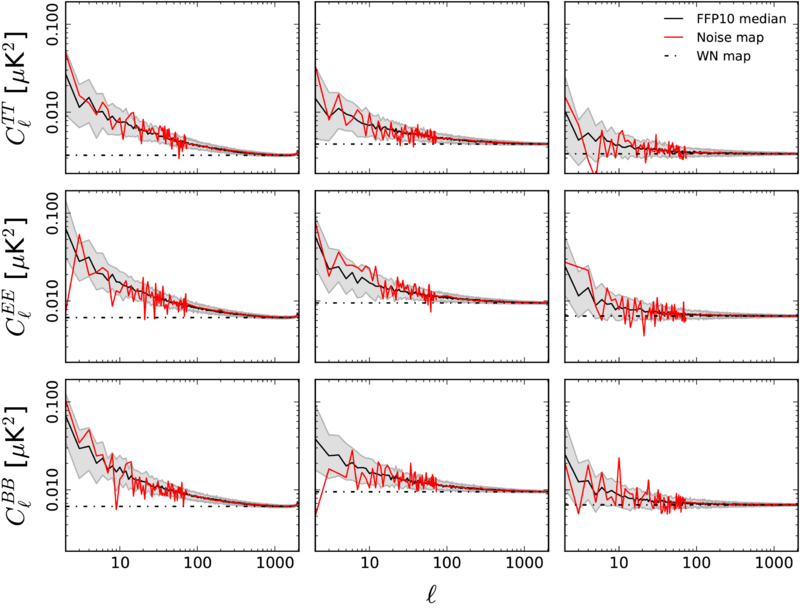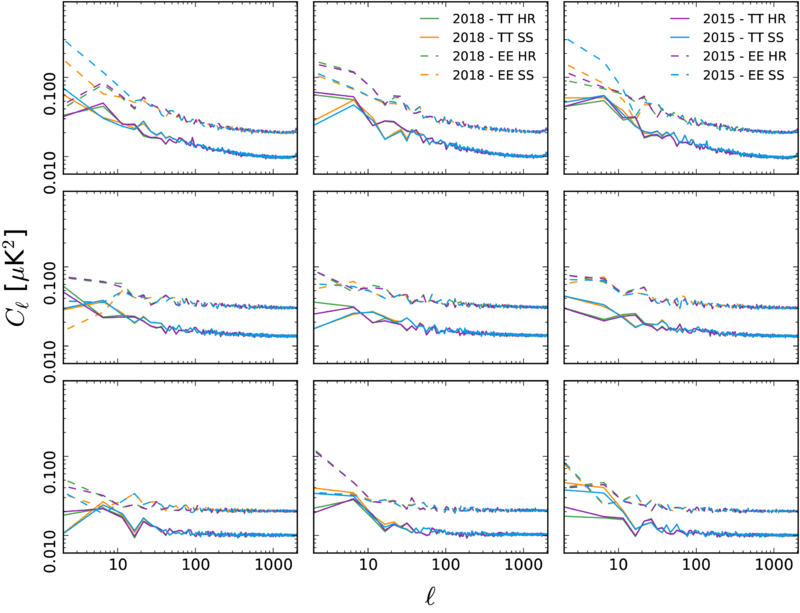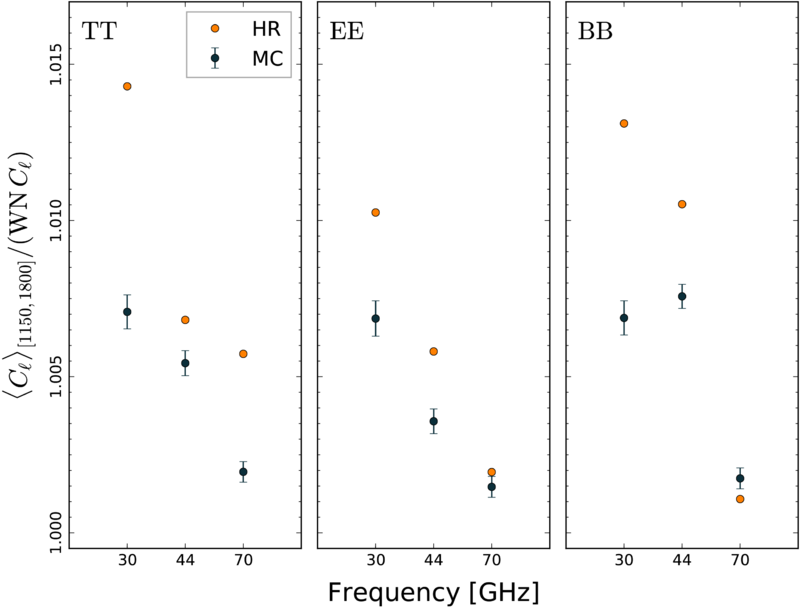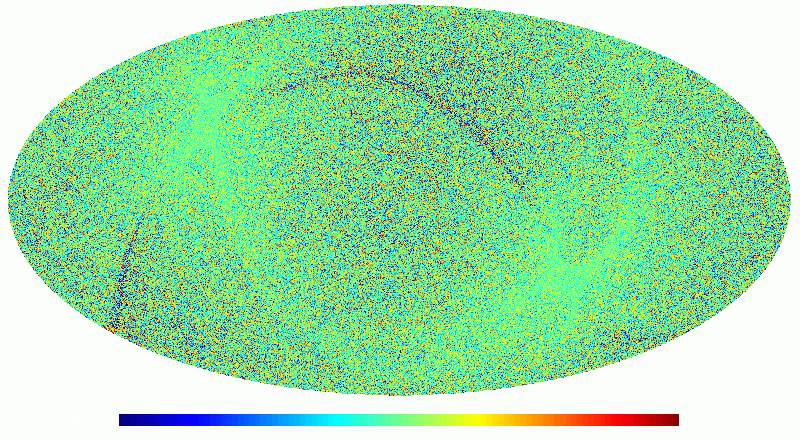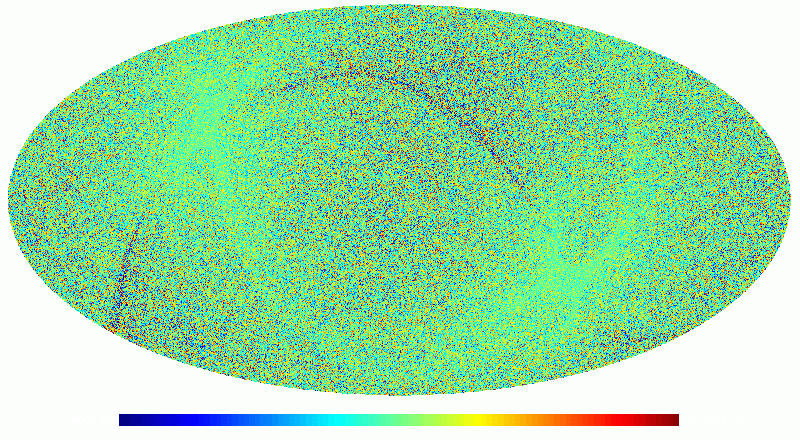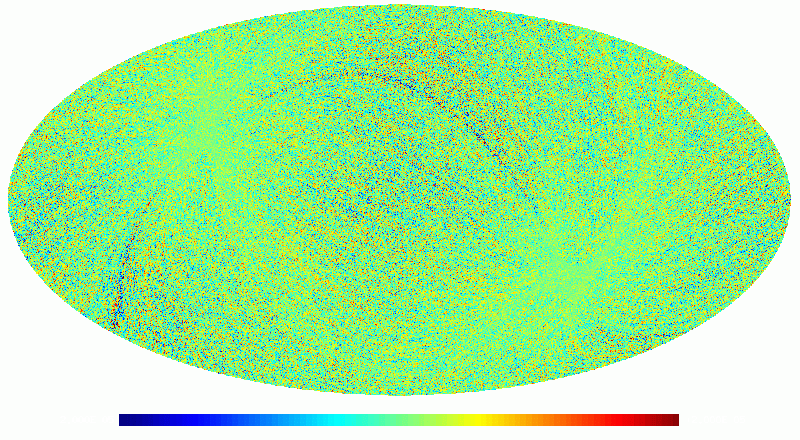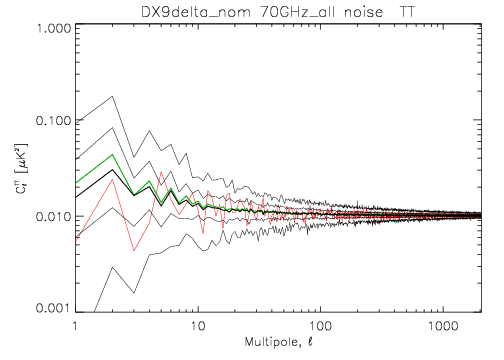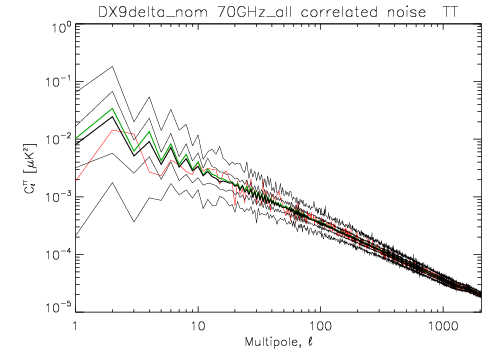Map-making LFI
Contents
[hide]Mapmaking[edit]
The inputs to the mapmaking procedure consist of the calibrated timelines, along with the corresponding pointing information. The main output consists of temperature and polarization maps. An important part of the mapmaking step is the removal of correlated 1/f noise.
LFI maps were constructed with the MADAM mapmaking code, version 3.7.4. The code is based on a generalized destriping technique, where the correlated noise component is modelled as a sequence of constant offset "baselines". The baseline solution is constrained by a noise filter. As auxiliary information, the code produces a hit-count map and a white noise covariance matrix. No beam information is used, with the signal being simply assigned to the pixel where the centre of the beam falls.
The chosen baseline length was 1s for the 44GHz and 70GHz maps, 0.25s for the 30GHz map. This gives good noise removal, without being computationally burdensome. The noise filter was built according to the noise parameters (see noise section). Flagged samples were excluded from the analysis. The Galaxy region was masked out in the destriping phase, to reduce errors arising from strong signal gradients. Radiometers were combined according to the horn-uniform weighting scheme to minimize systematics. The polarization component was included in the analysis and is part of this release. A detailed description of the mapmaking procedure is given in Planck-2013-II[1], Planck-2015-A02[2], Planck-2015-A06[3] no relevant changes has been applyed in the 2018 release. See also the section on Frequency Maps.
The maps are in HEALPix format, at resolution Nside=1024 for all frequencies with an additional map at Nside=2048 for the LFI 70GHz channel, in the nested pixelization scheme. Unobserved pixels are marked by a special value.
The released maps are in Galactic coordinates. The conversion between ecliptic and Galactic coordinates is described by the rotation matrix
The conversion was applied to the input pointing data, prior to the construction of the map.
Low-resolution maps and noise covariance matrices[edit]
To fully exploit the information contained in the large-scale structure of the microwave sky, pixel-pixel covariances are needed in the maximum likelihood estimation of the CMB power spectrum. However, full covariance matrices are impossible to employ at the native map resolution due to resource limitations. A low-resolution data set is therefore required for the low-ℓ analysis. This data set has been packed into three different files, one per frequency, called "LFI_NoiseCovMat_0??_0016_R3.00.tgz", that can be downloaded from the Cosmology section of the Planck Legacy Archive. They consist of low-resolution maps, and descriptions of residual noise present in those maps given by pixel-pixel noise covariance matrices (NCVMs). Note the in the 2018 release the Low-resolution maps full mission coverage, excluding Surveys 2 and 4 has not been used. We release them for crosschecking purposes with respect 2015 release.
| Filenames | Comment |
|---|---|
| LFI_SkyMap_0??_0016_coswin_DX12_full_regnoise.fits | Low-resolution maps. Full mission coverage. |
| LFI_SkyMap_0??_0016_coswin_DX12_Corrected_full_regnoise.fits | Low-resolution maps BandPass Corrected. Full mission coverage. Corrected for the BandPass. |
| LFI_SkyMap_0??_0016_coswin_DX12_s1-s3-s5-s6-s7-s8_regnoise.fits | Low-resolution maps. Full mission coverage, excluding Surveys 2 and 4. |
| LFI_SkyMap_0??_0016_coswin_DX12_Corrected_s1-s3-s5-s6-s7-s8_regnoise.fits | Low-resolution maps. Full mission coverage, excluding Surveys 2 and 4. Corrected for the BandPass. |
| offset_covmat_toast_nside64T16_coswin_025sec_??GHz_DX12_full_bin.dat | Low-resolution noise covariance matrices. Regularization noise added. Format: C unformatted. |
| offset_covmat_toast_nside64T16_coswin_025sec_??GHz_DX12_s1-s3-s5-s6-s7-s8_bin.dat | Low-resolution noise covariance matrices. Regularization noise added. Format: C unformatted. |
| covmat_toast_nside64T16_coswin_025sec_??GHz_DX12_full_bin.dat | Low-resolution noise covariance matrices. No regularization noise added. Format: C unformatted. |
| covmat_toast_nside64T16_coswin_025sec_??GHz_DX12_s1-s3-s5-s6-s7-s8_bin.dat | Low-resolution noise covariance matrices. No regularization noise added. Format: C unformatted. |
| mask_comm17Tv2_pol_R2.2x_ns16_nest.fits | Low-resolution Mask 2.2. |
| mask_comm17Tv2_pol_R1.8x_ns16_nest.fits | Low-resolution Mask 1.8. |
| offset_RESCALED_base_bestfit_cov_IQU.da | Rescaled noise ONLY for 70 GHz. C unformatted. |
The low-resolution data set can currently be utilized efficiently only at resolution Nside = 16, or lower. All the low-resolution data products are produced at this target resolution.
Low-resolution maps[edit]
A number of different schemes to obtain the low-resolution maps are discussed in [4]. We chose to downgrade the maps using the inverse noise weighting, no changes on the procedure has been applyed to the 2018 release. This is discussed further in Planck-2013-II[1]Planck-2015-A06[3].
Inputs[edit]
We took the high-resolution maps described in Map-making and Frequency Maps, and the corresponding 3×3 matrices as an input for this analysis step.
Production[edit]
The high-resolution maps were downgraded to Nside = 16 using inverse noise weights (given by the 3×3 matrices), and subsequently the temperature part was smoothed with a symmetric Gaussian beam with FWHM = 440arcmin.
Noise covariance matrices[edit]
The statistical description of the residual noise in the maps is given in the form of a pixel-to-pixel noise covariance matrix (NCVM), as described in [4].
Inputs[edit]
The noise model was determined by three noise parameters: the white noise level σ; slope; and knee frequency fknee. We actually used three sets of noise parameters, one for the entire mission (noise parameters are listed in Table 1), and one for each sky survey (SS1 and SS2).
We used the same pointing as in the noise Monte Carlo simulations. See the description in Noise Monte Carlo Simulation Inputs.
We used the gap files produced during the making of the flight maps to leave out samples that were flagged as bad for various reasons.
Production[edit]
The output of the NCVM module of MADAM mapmaker are inverse NCVMs. Since the inverse matrices are additive, we divided the computations into a number of small chunks to save computational resources. We first calculated one inverse NCVM per radiometer per survey at resolution Nside=32, and then combined these individual inverse matrices to form the actual inverse matrices. The mapmaking parameters were almost identical to the standard mapmaking runs. The differing parameter values are listed below:
- baseline lengths were 0.25s for 30GHzand 1.0s for 44GHz, and 70GHz;
- the calculations were performed at resolution Nside = 64;
- no destriping mask was applied;
- the horns were weighted optimally.
To obtain the noise covariance from its inverse, the matrices are inverted using the eigen decomposition of a matrix. The monopole of the temperature map cannot be resolved by the mapmaker, and thus the matrix becomes singular. This ill-determined mode is left out of the analysis.
Having calculated the eigen decomposition in the previous step, we can apply the same linear operators to modify the eigenvectors as were applied to the high-resolution maps while downgrading them. The eigenvectors are downgraded to Nside = 16 using inverse noise weights, and subsequently the temperature part is smoothed with a symmetric Gaussian beam with FWHM = 440arcmin.
The final matrices are then recomposed from the original eigenvalues and modified eigenvectors.
The low-resolution noise covariance matrices:
- are C binary format files;
- are organized in block form,
- are in the HEALPix nested pixelisation scheme (with resolution is Nside = 16, and thus there are Npix = 3072 pixels);
- are in Galactic coordinates;
- have KCMB units.
Half-ring jackknife noise maps[edit]
Overview[edit]
In the 2018 release we follow the same procedure as in Planck-2015-A03[2] in order to estimate the noise directly at the map level and in the angular power spectra.
Briefly, instead of using the full time-ordered data as described above, we produced two sets of maps using either only the first half of each pointing period (map named j1 below) or only the second half of each pointing period (map named j2). At each pixel p, these half-ring jackknife maps j1 and j2 contain the same sky signal, since they result from the same scanning pattern on the sky. However, because of instrumental noise, the maps j1 and j2 are not identical.
We estimated the noise level in each map m made using the full (ring) data, by constructing a half-ring difference map
with weights
.
Here hitfull(p) = hit1(p) + hit2(p) is the hit count at pixel p in the full map m, while hit1 and hit2 are the hit counts of j1 and j2, respectively. The weight factor whit(p) is equal to 2 only in those pixels where hit1(p) = hit2(p) . In a typical pixel, hit1(p) will differ slightly from hit2(p) and hence the weight factor is whit(p)>2.
The half-ring difference maps nm are the most direct measure of the noise in the actual maps. The other noise estimates (NCVM and noise Monte Carlo) rely on specific modelling of the noise and this modelling can be validated by comparing to the half-ring difference maps. However, the half-ring difference maps can only capture the noise that varies faster than half of the duration of the pointing period, i.e., the noise whose frequency is approximately f > 1/20min = 0.85mHz.
We calculated the noise maps nm, from half-ring "jackknife" maps for temperature (I) and polarization (Q and U) and as a first quality check of the maps (and as one of the tests of the whole data processing pipeline up to the map level) tested both numerically and visually that these noise maps divided pixel-by-pixel by the square root of the white noise covariance maps were approximately Gaussian with variance near to unity. Temperature noise maps for the nominal survey and for the first and second sky surveys are shown in the next subsection. Furthermore we calculated from the noise maps the temperature and polarization (E and B mode) auto-correlation and cross-correlation noise angular power spectra using HEALPix anafast and compared to these the results from the white noise covariance matrices and from the noise Monte Carlo simulations. A similar comparison was made between downgraded half-ring noise maps, downgraded noise Monte Carlo maps, and the low-resolution noise covariance maps. Detailed results are presented in Planck-2020-A2[5].
Comparison of noise estimates using Half-Ring[edit]
Here we compare noise angular power spectra estimated from half-ring difference maps (red), white noise covariance maps (black dash-dotted lines), and 100 full noise Monte Carlo simulations (grey band showing range for 16th and 84th quantiles of noise simulations, and the black solid lines giving the median, i.e., 50th quantile, of distributions). See the next section for details of noise Monte Carlo simulations. From top to botto we show TT, EE and BB power spectra for 30 GHz (left), 44 GHz (centre), and 70 GHz (right). Half-ring spectra are binned with for .
Below the null-tests comparing power spectra from survey differences to those from teh half-ring maps are showed. Difefrences are: left, Survey 1 - Survey 2; Middle , Survey 1- Survey 3; and right, Survey 1 - Survey4. these are for 30 GHz (top), 44 GHz (middle), and 70 GHz (bottom), for both TT and EE power spectra. There is a significant improvement in Surve1 - Survey 2 and Survey 1 - Survey 4 at 30 GHz, especially in EE. See Planck-2020-A2[5] for further details.
High-ell average noise relative to white noise estimate[edit]
The figure below is the same as the previous figures, but here the noise comparison is made from the high ℓ tails of the angular power spectra, where the white noise dominates. We have taken the average of Cℓ from multipoles between 1150 and 1800 for both temperature and polarization and tehn comparing with the WNCVM. As already shown in previous releases, there is still an excess of 1/f noise, meaning tha both the real data and the noise MCs predict slightly larger noise than the WNCVM. It is important to note that such noise excess is reduced considerably with respect to the 2015 release.
Noise Monte Carlo simulations[edit]
Overview[edit]
Calculating and handling full pixel-to-pixel noise covariance matrices for Planck maps if feasible only at low resolution. To support the analysis of high-resolution maps, a Monte Carlo set of noise maps were produced. These maps were produced from noise timelines using the same map-making procedure as for the flight data. In the noise Monte Carlo it was possible to follow exactly the mapmaking procedure used for the flight maps, whereas for the calculation of noise covariance matrices some approximations had to be made. Such noise Monte Carlos were produced at two levels of the analysis: (1) LFI Monte Carlo (MC) as part of the LFI data processing procedure; and (2) Full Focal Plane (FFP) Monte Carlos as part of the joint HFI/LFI data processing. This page describes the LFI noise MCs. For the FFP MC, see HL-sims and Simulation data.
Inputs[edit]
The noise MC uses a three-parameter noise model, consisting of white noise level (σ), slope, and knee frequency (fknee)). Here the noise consists of white noise and correlated 1/f noise, with a power spectrum
- ,
where fsample is the sampling frequency of the instrument. The noise parameters were determined separately for each radiometer, as described in the section Noise above, assuming they stayed constant over the mission.
The detector pointing was reconstructed from satellite pointing information, focal-plane geometry, pointing correction (tilt angle), and sample timing, using Level-S simulation software. The same pointing solution (two focal planes) was used as for the LFI flight maps. Due to numerical accuracy, the detector pointing in the noise MC was not exactly the same as for the flight maps, so some data samples (of the order of one in a thousand) whose pointing was near the pixel boundary ended up assigned to the neighbouring pixel. During mapmaking from the flight data, a "gap file" was produced to represent the samples that were omitted from mapmaking due to various flags. This gap file was used in the noise MC instead of the full set of flags. The flight mapmaking procedure used destriping masks to prevent regions of strong signal gradients from contributing to the noise baseline solution. These same destriping masks (one for each frequency channel) were used for the noise MC.
Production[edit]
The noise was generated internally in the Madam mapmaking code using a stochastic differential equation (SDE) method, to avoid time-consuming writing and reading of noise timelines to and from disk. Noise for each pointing period was generated separately, using a double-precision random number seed constructed from the realization number, radiometer number, and the pointing period number; this allowed for regeneration of the same noise realization when needed. White noise and 1/f noise were generated separately.
The same mapmaking code (Madam) with the same parameter settings was used for the noise MC as for the flight maps. In addition to the destriped maps from the full noise (output maps), binned maps from just the white noise (binned white noise maps) were produced; they represent the white noise part of the output maps. The difference between these two maps represents the residual correlated noise in the output map. The maps were made at HEALPix resolution Nside = 1024 for all LFI frequency channels and also at HEALPix resolution Nside = 2048 for the 70 GHz channel. For low-resolution analysis, these maps were downgraded (and the temperature part was smoothed) to Nside = 32 and Nside = 16.
In addition to frequency maps for the nominal survey, also single-survey and 70 GHz horn-pair maps were produced in the noise MC. For each case 102-1026 realizations were produced.
Usage[edit]
These noise Monte Carlo maps were used for a number of purposes in LFI data analysis. They were compared to the low-resolution noise covariance matrices, generated for the same noise model, in order to reveal the impact of the approximations in the noise covariance matrix calculation. They were compared to the half-ring noise maps to see how well the noise model matches the noise in the flight maps (noting, however, that the half-ring noise maps misrepresent the lowest noise frequencies in the flight maps, and contain some effects from the sky signal). They were also used in power spectrum estimation and non-Gaussianity estimation.
Examples[edit]
As an example, we show below images of the first realization of the 70GHz frequency map noise for the nominal survey. The images are in the order: destriped full noise; binned white noise; and residual correlated noise. Note that it is difficult to see any difference between the first two images, since the residual correlated noise is more than an order of magnitude below the white noise level. The units here are KCMB.
The following two images show the statistics of the angular power spectra of 101 realizations of the 70 GHz frequency map noise for the nominal survey. The thick black line shows the median Cℓ, while the green line the mean Cℓ. Thin black lines show the minimum, 16th percentile, 84th percentile, and the maximum Cℓ. The red line is the 102nd realization. The first plot is for the full noise in the output map, while the second plot is for the residual correlated noise.
References[edit]
- ↑ Jump up to: 1.01.1 Planck 2013 results. II. Low Frequency Instrument data processing, Planck Collaboration, 2014, A&A, 571, A2.
- ↑ Jump up to: 2.02.1 Planck 2015 results. II. LFI processing, Planck Collaboration, 2016, A&A, 594, A2.
- ↑ Jump up to: 3.03.1 Planck 2015 results. VI. LFI mapmaking, Planck Collaboration, 2016, A&A, 594, A6.
- ↑ Jump up to: 4.04.1 Residual noise covariance for Planck low-resolution data analysis, R. Keskitalo, M. A. J. Ashdown, P. Cabella, T. Kisner, T. Poutanen, R. Stompor, ArXiv e-prints, (2013).
- ↑ Jump up to: 5.05.1 Planck 2018 results. II. Low Frequency Instrument data processing, Planck Collaboration, 2020, A&A, 641, A2.
(Planck) Low Frequency Instrument
(Hierarchical Equal Area isoLatitude Pixelation of a sphere, <ref name="Template:Gorski2005">HEALPix: A Framework for High-Resolution Discretization and Fast Analysis of Data Distributed on the Sphere, K. M. Górski, E. Hivon, A. J. Banday, B. D. Wandelt, F. K. Hansen, M. Reinecke, M. Bartelmann, ApJ, 622, 759-771, (2005).
Cosmic Microwave background
Full-Width-at-Half-Maximum
(Planck) High Frequency Instrument
